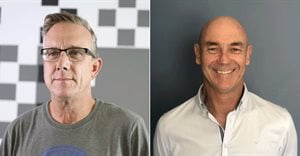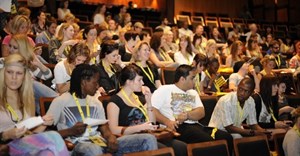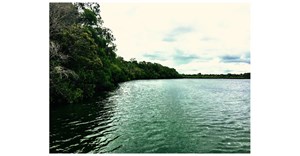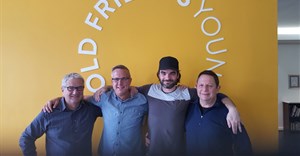[Design Indaba 2014] The democratisation of design
One of the best examples of this throwing off of the process-driven shackles of old was presented by the chief creative officer of Ogilvy & Mather South Africa, Chris Gotz (@MrChristiffa), who relayed that the agency had entered a new way of being in the last six years, centring on the celebration of the freedom of creativity and encouraging random collaboration devoid of set structures.
![[Design Indaba 2014] The democratisation of design](https://biz-file.com/c/1402/181257.jpg)
Every child is an artist - the challenge is to remain one
"When children go to school they have their dreams scooped out of them to make space for the nine times table! Society expects us to do something practical and as such, we live in a world that bows down to Maths, Physics and Science. Through the creation of a more seamless process we've created an environment centred on the idea that 'Possibility lurks here' where people argue, fire ideas at one another and in so doing come up with real ideas."
The first project the agency completed under its new collaborative mantle was a farewell campaign for the iconic 25 year old Citi Golf brand. "We decided to focus on the fact that there would have to be one last car coming off the production line and we wanted to capture the sadness and sentimentality associated with this.
"By getting people to sign the car as it travelled across the country, consumers became part of the story of the brand and the campaign achieved incredible results thanks to its interactive nature via Facebook, Twitter and Online channels."
CHRIS GOTZ - Creatives need to interact to share their preciousness. OK is NOT OK! Starting from nothing gives a clean edge. #designindaba
- Mauneen van Wyk (@MauneenvW) February 26, 2014Based on this and other projects it has undertaken since its rebirth in 2008, Chris said; "One of the biggest lessons we've learnt on our journey towards reinvention is that we need to stay super aware of the weird collisions in everyday life. Unfortunately, most people have a 'heads down' approach and constantly scour the internet as their primary or sole source of information which has resulted in a deficit of primary evidence.
"Despite our extremely limited attention span, we need to discover more things first hand as opposed to basing all our thinking on someone else having seeing something else that happened to them."
![[Design Indaba 2014] The democratisation of design](https://biz-file.com/c/1402/181258.jpg)
There are no mistakes only opportunities
Another speaker who touched on the value of real insights in the creative process was Jake Barton (@jake_barton) from US based media design company, Local Projects, that was recently voted one of the top ten most innovative design firms by Fast Company Magazine, and uses the art of storytelling and moments of listening to create interactive museum and public space experiences.
Jake's key insight was that we need to let the modern day tools we use to make something - namely technology - influence what we're actually making.
One of the recent projects where Jake and his team have put that insight to excellent use is the new wing of the $350-million Cleveland Museum of Art. "Our approach to the design of the new wing of the museum stemmed from the idea that we need to reinvent galleries around technologies themselves.
"The issue we often face, however, is that despite the digital revolution stampeding through society at a rapid pace very few institutions want to mess up their status quo. No one wants to get it wrong and bankrupt themselves over new initiatives.
"With the Cleveland Museum of Art project we felt there was absolutely no need to reinvent the wheel, but what we did want to do was harness the direct relationships between the museum's patrons and its artworks and we felt technology provides excellent tools for us to do just that".
The museum had already deployed one iPad per artwork but we did away with 80% of screens. Those that remained utilised a new interface that was designed around creating rich context to what people were seeing so it became about what they are looking at in real time.
When improvising, @Jake_Barton has these 3 tips: Start with yes, make statements, there are no mistakes, only opportunities. #designindaba
- Creative Cape Town (@CreativeCT) February 26, 2014Jake pointed out that a key aspect of the way in which his team designs interactions, is the 'just build it!' approach. "We construct a prototype and then use that as a working model to shape ideas and projects going forward. This has become a key aspect of our creative process based on our view that until you see something working, you have no idea how people will move and interact with it."
Even the thinnest flat screen TV is going to look like a toaster in a year!
Jake also made the point that nothing ages faster than cutting edge technology! "Most technology is awash in its newness which can be very intoxicating for even the most disciplined designer, but the reality is that even the thinnest flat screen TV is going to look like a toaster in a year! It's not super hard to be first to do X Y Z but it is hard to make meaning out of it. If you make something that has meaning, it won't age."
U don't need 2 reinvent the art museum. Ppl still need a direct relationship w/the artworks. Digital should amplify not replace @Jake_Barton
- Design Indaba (@designindaba) February 26, 2014"These overlapping oral history memories have a real, raw quality as opposed to a top down view from a detached historian, which also makes the entire experience far more meaningful and memorable," said Jake.


For more:
- Bizcommunity Special Section: Design Indaba
- Bizcommunity Search: Design Indaba
- Bizcommunity Galleries: Design Indaba
- Design Indaba website: www.designindaba.com
- Facebook: Design Indaba
- Twitter: @DesignIndaba
- Twitter Search: Design Indaba OR designindaba OR DI2014
- Google News Search: Design Indaba








